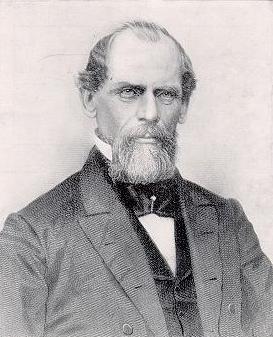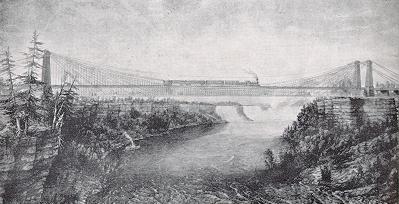The Towers
- A suspension bridge
- John A. Roebling, designer
- Niagra gorge bridge
- Financial Difficulties and Civil War
A suspension bridge

In the early 1850s, the Lexington and Danville Railroad began the construction of a railroad bridge at a location just below the confluence of the Kentucky and Dix Rivers. Originally planned as a suspension bridge, it was designed by John Roebling, who would later design the famous Brooklyn Bridge in New York City. At the same time, John Roebling was working on a suspension bridge across the Niagara river gorge that would connect the New York Central and Great Western Railway of Canada. In March 1855, when the first locomotive and train crossed the Niagara suspension bridge, it was considered a triumph of engineering and demonstrated the feasibility of the Kentucky River bridge. Sadly, the finances of the Lexington and Danville Railroad could not sustain the construction. The towers for the suspension bridge were build, but little else.
The John Roebling biography explains:
Simultaneous with the progress of the Niagara bridge, another railway suspension bridge was commenced by Mr. Roebling across the Kentucky River, on the line of the Southern Railroad leading from Cincinnati to Chattanooga. The gorge of the river in that region is deeper and wider than that of the Niagara, requiring a clear span of no less than 1,224 feet. The anchorage and stone towers were rapidly completed, and the necessary plates and saddles hoisted on the towers; most of the cable wire was delivered, as also the material for the superstructure, the girder principle adopted here being essentially different from that carried out in the Niagara Bridge, no floor for vehicles being required in this case; suddenly, however, the finances of the railway company collapsed, with the unfortunate result that the building of this stupendous bridge, already well advanced, was immediately stopped, as well as work on the railroad...
Had the suspension bridge been built, it would likely have looked quite similar to the Niagara bridge as shown below.
A larger picture of the Niagara bridge is available.
Also see the wood engraved color illustration, published in Gleason's Pictorial, 1854.
Other railroads also desired a river crossing for a north-south railroad route. The Civil War stopped all construction. The towers remained in place and would later provide the inspiration for the name of both the railroad station and the village.
Next (Bridge Construction)
